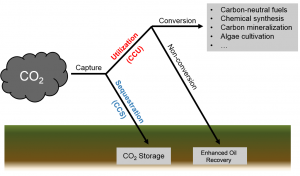Have you heard concerns regarding climate change in the past few years? I think almost everyone has, which goes to show how serious this global issue really is. One of the main causes of climate change is the release of excess carbon dioxide into the atmosphere, due to the burning of fossil fuels. If we could somehow reduce these greenhouse gas emissions, climate change would pose less of a threat to humanity.
A solution to climate change
One solution that scientists have proposed in order to reduce the amount of atmospheric carbon dioxide is to capture carbon dioxide in the air and use the captured carbon dioxide as a source of chemical carbon for other processes. This process is known as “carbon capture and utilization” (CCU). Although the potential benefits of CCU are very promising, changing the carbon dioxide into a different form and using it in other chemical processes has been proven to be difficult. Although CCU has gained major traction over the past few years, it will still require a lot of time before it can be used industrially worldwide. Scientists are currently in the process of trying to find the least costly, and most efficient means of capturing carbon emissions to reduce climate change.

Image: Carbon Capture and Utilization Process Source: Wikimedia Commons Relevance: Shows path of CO2 in this process
Carbon capture methods
One of the carbon capturing methods that has been showing promise in recent scientific studies, is the adsorption of carbon dioxide through the use of solid sorbents. Adsorption is the adhesion or the clinging of gas molecules onto a surface. In this case, the carbon dioxide molecules will stick to the solid surface of the sorbent, which leads to successful carbon capturing. The solid sorbents used in this method can be made of “porous carbonaceous materials, zeolites, alumina, silica, (or) metal-organic frameworks.” Adsorption of carbon dioxide can be categorized into two variations; physical and chemical adsorption. In physical adsorption, the transfer of carbon dioxide into the solid sorbent occurs due to the Van der Waals interactions (attraction between neutral molecules) between the sorbent and the carbon dioxide. The issue with these physical sorbents is that they have “poor selectivity for CO2 and low CO2 adsorption capacities.” A means of improving both the carbon dioxide selectivity and the carbon dioxide adsorption capacities of these sorbents is by adding basic groups to the sorbent surface, which can strengthen its interactions with the acidic carbon dioxide. Although carbon dioxide adsorption via solid sorbents is very promising, more scientific work needs to be done to improve the adsorption capabilities of sorbents.
 Video: Carbon Capture Plant in Squamish, BC
Video: Carbon Capture Plant in Squamish, BC
Although CCU has gained major traction over the past few years, it will still require a lot of time before it is used industrially worldwide, and this timeline is uncertain. Moving forward, scientists must also be wary of the energy consumption of these carbon capture mechanisms, as they could use “a quarter of global energy in 2100”.
– Yoshinao Matsubara
